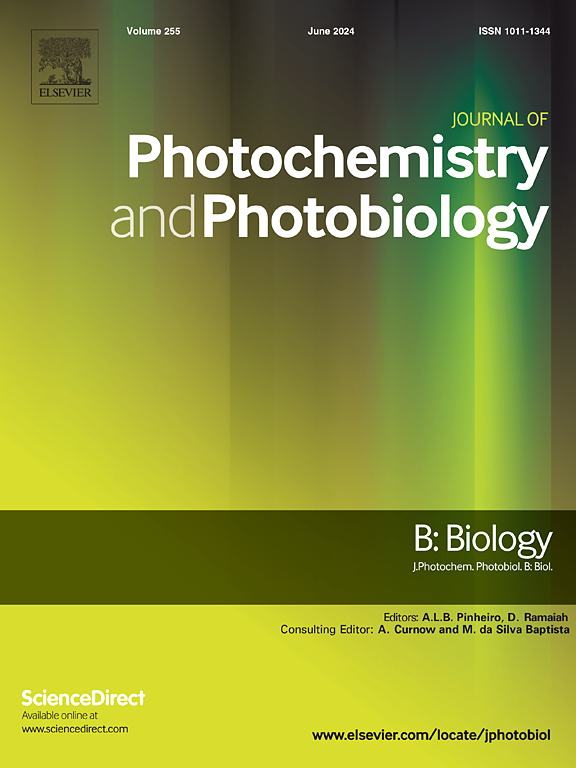A hydroxyl coumarin-chalcone-based fluorescent probe for sensing copper ions in plant and living cells
IF 3.9
2区 生物学
Q2 BIOCHEMISTRY & MOLECULAR BIOLOGY
Journal of photochemistry and photobiology. B, Biology
Pub Date : 2025-07-05
DOI:10.1016/j.jphotobiol.2025.113218
引用次数: 0
Abstract
Copper ions are essential trace elements for living organisms. However, its excessive levels in the liver and kidneys may lead to severe health issues. Therefore, developing effective fluorescent probes for detecting copper ions is crucial. A hydroxyl coumarin chalcone derivative featuring a hydroxyl substituent has been developed as a fluorescent probe for monitoring Cu2+. The probe can selectively detect Cu2+ in aqueous solutions, exhibiting a visible color change from red to light yellow to the naked eye. This is accompanied by a quenching of the red fluorescence, with a limit of detection of 11.2 μM. By utilizing Fourier transform infrared spectroscopy, fluorescence spectral changes upon alternating addition of Cu2+ and ethylene diamine tetraacetic acid, high-resolution mass spectrometry, and Job's plot analysis, along with a comparison of properties to a structurally analogous compound lacking a hydroxyl substituent, we propose that the probe engages in a 1:1 coordination reaction between its hydroxyl, adjacent carbonyl groups and Cu2+. The probe was successfully employed for the quantitative determination of Cu2+ content in a variety of real water, beverage and plant samples. Furthermore, the probe exhibits excellent biocompatibility, emitting bright fluorescence under confocal microscopy, which allows for the monitoring of intracellular Cu2+ level fluctuations.

基于羟基香豆素-查尔酮的荧光探针,用于感应植物和活细胞中的铜离子
铜离子是生物必需的微量元素。然而,它在肝脏和肾脏中的过量水平可能会导致严重的健康问题。因此,开发有效的荧光探针来检测铜离子是至关重要的。以羟基取代基为特征的羟基香豆素查尔酮衍生物作为监测Cu2+的荧光探针被研制出来。该探针可以选择性地探测水溶液中的Cu2+,呈现出肉眼可见的由红色到淡黄色的颜色变化。这伴随着红色荧光的猝灭,检测限为11.2 μM。通过利用傅里叶变换红外光谱、交替加入Cu2+和乙二胺四乙酸时荧光光谱的变化、高分辨率质谱和Job图分析,以及与缺乏羟基取代基的结构类似化合物的性质比较,我们提出探针在其羟基、相邻羰基和Cu2+之间进行1:1的配位反应。该探针成功地用于各种实际水、饮料和植物样品中Cu2+含量的定量测定。此外,该探针表现出优异的生物相容性,在共聚焦显微镜下发出明亮的荧光,从而可以监测细胞内Cu2+水平的波动。
本文章由计算机程序翻译,如有差异,请以英文原文为准。
求助全文
约1分钟内获得全文
求助全文
来源期刊
CiteScore
12.10
自引率
1.90%
发文量
161
审稿时长
37 days
期刊介绍:
The Journal of Photochemistry and Photobiology B: Biology provides a forum for the publication of papers relating to the various aspects of photobiology, as well as a means for communication in this multidisciplinary field.
The scope includes:
- Bioluminescence
- Chronobiology
- DNA repair
- Environmental photobiology
- Nanotechnology in photobiology
- Photocarcinogenesis
- Photochemistry of biomolecules
- Photodynamic therapy
- Photomedicine
- Photomorphogenesis
- Photomovement
- Photoreception
- Photosensitization
- Photosynthesis
- Phototechnology
- Spectroscopy of biological systems
- UV and visible radiation effects and vision.

 求助内容:
求助内容: 应助结果提醒方式:
应助结果提醒方式:


